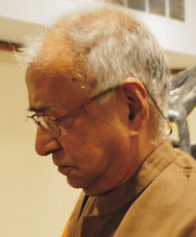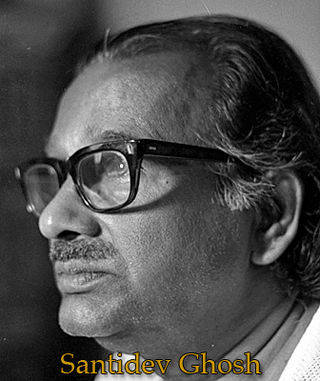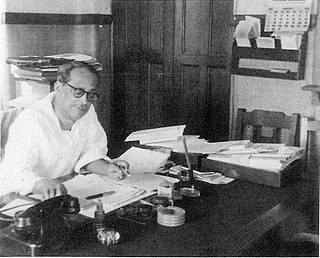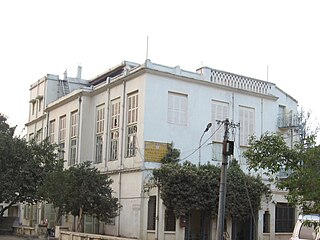
Shantiniketan is a neighbourhood of Bolpur town in the Bolpur subdivision of Birbhum district in West Bengal, India, approximately 152 km north of Kolkata. It was established by Maharshi Devendranath Tagore, and later expanded by his son, Rabindranath Tagore whose vision became what is now a university town with the creation of Visva-Bharati.

Visva-Bharati is a public central university and an Institution of National Importance located in Shantiniketan, West Bengal, India. It was founded by Rabindranath Tagore who called it Visva-Bharati, which means the communion of the world with India. Until independence it was a college. Soon after independence, the institution was given the status of a central university in 1951 by an act of the Parliament.

Kanika Banerjee was an Bengali Rabindra Sangeet singer.

Patha Bhavana is an institution of primary and secondary education in Santiniketan, West Bengal, India. Founded by Nobel laureate Rabindranath Tagore in 1901, starting with only five students, the school is characterized by its philosophy of learning with the heart in closeness to nature without any superficial barriers between teachers and students, as opposed to the strict, repetitive and the rote learning system that was mainstream during Tagore's childhood. Often referred to as an ashram system, initially what started out as this school, later grew into what is now Visva-Bharati University. It is one of the two primary and secondary school affiliated with the Visva-Bharati University; the other being Siksha Satra.

Bolpur is a city and a municipality in Birbhum district in the state of West Bengal, India. It is the headquarters of the Bolpur subdivision. Bolpur municipal area includes Santiniketan, Sriniketan and Prantik. The city is known as a Cultural and Educational hub of West Bengal. The city is under the Jurisdiction of Bolpur and Santiniketan Police station. Bolpur is the largest and most populous city in Birbhum district and 28th most populous city in West Bengal. Located on the banks of Ajay River and Kopai (Sal) River, Bolpur has been a major Human settlement. It is 150 km north of Kolkata and is famous for Visva Bharati, the University set up by the Nobel laureate poet Rabindranath Tagore.

Malati Devi Choudhury was an Indian civil rights and freedom activist and Gandhian. She was born in 1904 in an upper middle class Brahmo family. She was the daughter of Barrister Kumud Nath Sen, whom she had lost when she was only two and a half years old, and Snehalata Sen, who brought her up.

Poush Mela is an annual fair and festival that takes place in Santiniketan, in Birbhum District in the Indian state of West Bengal, marking the harvest season. Commencing on the 7th day of the month of Poush, the fair officially lasts for three days, although vendors may stay until the month-end as per the university regulations. From 2017 onwards, the fair lasted for six days. The key characteristic of this fair include live performances of Bengali folk music, such as baul, kirtan and Kobigan.

Kalpathi Ganpathi "K.G." Subramanyan was an Indian artist. He was awarded the Padma Vibhushan in 2012.

Santidev Ghose was an Indian author, singer, actor, dancer and maestro of Rabindra Sangeet.
Sriniketan is a neighbourhood of Surul in Bolpur subdivision of Birbhum district in the Indian state of West Bengal. It is adjacent to Santiniketan and houses the second campus of Visva-Bharati University. The Palli Samgathana Vibhag and Palli Siksha Bhavana are located in west bengal

Amar Kutir, once a place of refuge for independence movement activists has been turned into a cooperative society for the promotion of arts and crafts. It is located on the banks of the Kopai River, about 15 kilometres (9.3 mi) from Santiniketan in Birbhum district in the Indian state of West Bengal.

Surul is a census town in Bolpur Sriniketan CD block in Bolpur subdivision of Birbhum district in the Indian state of West Bengal.

Prabodh Chandra Bagchi or P. C. Bagchi was one of the most notable Sino -Indologists of the 20th century. He was the third Upacharya (Vice-Chancellor) of Visva-Bharati University.

Kala Bhavana is the fine arts faculty of Visva-Bharati University, in Shantiniketan, India. It is an institution of education and research in visual arts, founded in 1919, it was established by Nobel laureate Rabindranath Tagore.

Rathindranath Thakur was an Indian educationist, agronomist and painter. He served as the first vice-chancellor of Visva-Bharati University, which was founded by his father, Rabindranath Tagore.
The following is a list of notable people associated withVisva- Bharati University and/or Santiniketan, a neighbourhood in Bolpur city in West Bengal, India:

Cheena Bhavana, of Visva-Bharati University, founded in 1937, is a centre of Sino-Indian cultural studies located at Santiniketan in West Bengal, India. Its reputation as a center promoting historical study and modern relations between the two countries was built by such figures as Rabindranath Tagore and Tan Yun-Shan. The library is known for a major collection of Chinese books and journals, especially Buddhist scriptures and texts.
Tan Yun-Shan was a Chinese scholar and founder of Santiniketan's Cheena Bhavana, the oldest centre of Chinese studies in South Asia. He devoted his life to the cause of Sino-Indian cultural friendship.

Palli Samgathana Vibhaga, of Visva-Bharati University, was established at Sriniketan in 1922, by the Nobel laureate Rabindranath Tagore. Leonard Knight Elmhirst was its first director.
Santosh Chandra Majumdar was one of the first five students of Brahmaviyalaya at Santiniketan and was associated with Santiniketan most of his later life.
















